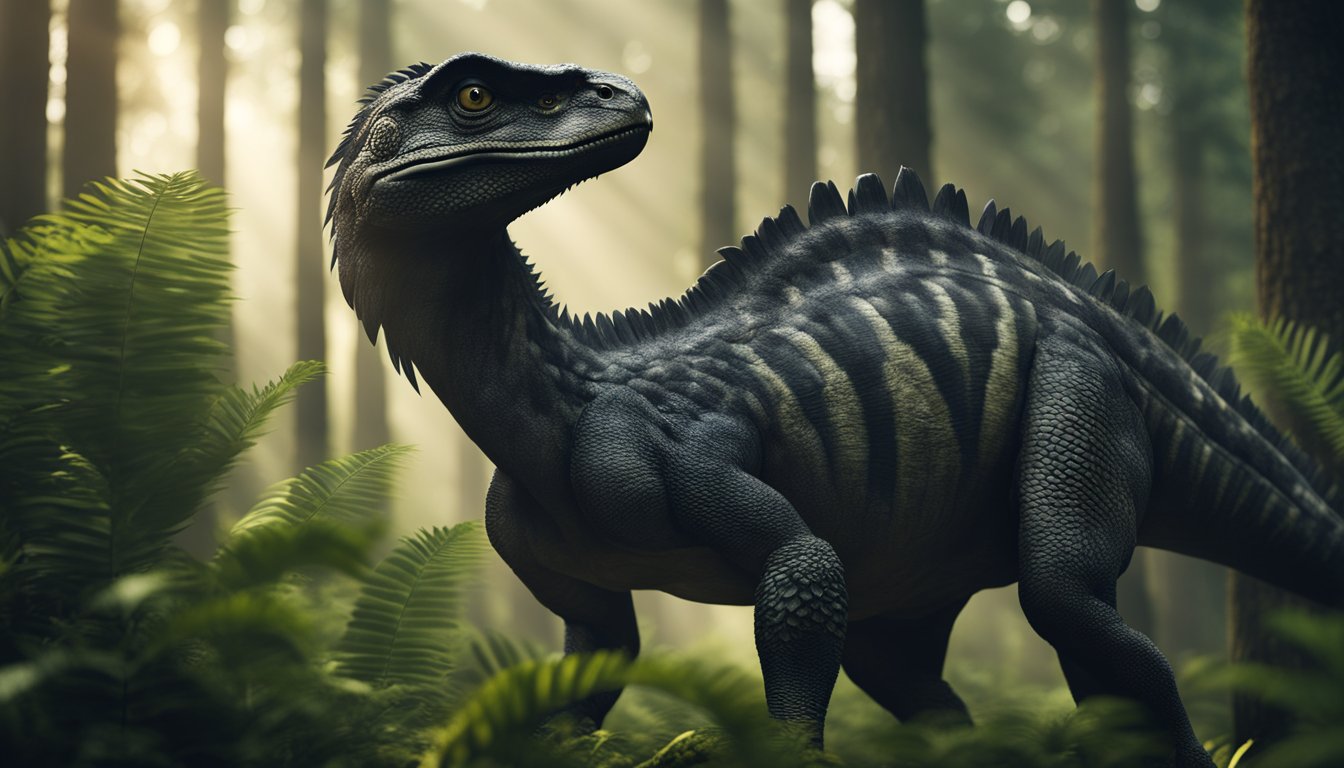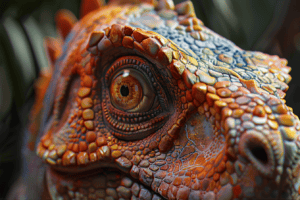Yutyrannus, the feathered tyrant of ancient China, was a dinosaur like no other.
Unlike most other dinosaurs, Yutyrannus had feathers, which makes it a unique and fascinating creature to study.
Yutyrannus lived during the early Cretaceous period in what is now northeastern China.

The discovery of Yutyrannus fossils was a significant breakthrough in the field of paleontology.
Before the discovery of Yutyrannus, scientists believed that only small dinosaurs had feathers.
However, the discovery of Yutyrannus proved that even large dinosaurs like the tyrannosaurs could have feathers.
The feathers were likely used for insulation, display, or possibly even flight.
Despite being a fearsome predator, Yutyrannus was not the largest dinosaur to have ever lived. It was about 30 feet long and weighed around 1.3 tons.
However, it was the largest known dinosaur to have had feathers, which makes it an important and intriguing creature to study.
Discovering the Yutyrannus
The discovery of Yutyrannus, the feathered tyrant of ancient China, was a groundbreaking moment in the world of paleontology.
This section will explore how fossils of this incredible dinosaur were found and how it got its name.
Fossil Findings in Liaoning
In the early 2000s, paleontologists were excavating fossils in Liaoning Province, China, when they stumbled upon something extraordinary.
They discovered the fossils of a large theropod dinosaur that had feathers.
This was the first time that scientists had found evidence of feathers on a dinosaur this large.
The fossils were remarkably well-preserved, with the feathers and bones still intact.
The discovery of this dinosaur was a turning point in our understanding of the evolution of feathers and their role in the dinosaur kingdom.
Yutyrannus Huali: Unveiling the Name
The dinosaur was given the name Yutyrannus huali, which means “beautiful feathered tyrant” in Mandarin and Latin.
The name was chosen because of its large size and the presence of feathers.
The discovery of Yutyrannus has provided scientists with valuable insights into the evolution of feathers and their role in the dinosaur kingdom.
It has also sparked new questions about the relationship between dinosaurs and birds.
Xing Xu, a paleontologist at the Chinese Academy of Sciences, was one of the scientists who discovered Yutyrannus.
He believes that the discovery of this dinosaur is just the tip of the iceberg and that there are many more feathered dinosaurs waiting to be discovered.
In conclusion, the discovery of Yutyrannus has revolutionized our understanding of the dinosaur kingdom.
It has shown us that these ancient creatures were much more diverse and complex than we ever imagined.
The fossils of Yutyrannus serve as a reminder of the incredible diversity of life that has existed on our planet for millions of years.
Anatomy of a Feathered Giant

Yutyrannus was a feathered tyrannosaur that roamed the earth during the early Cretaceous Period, approximately 130 million years ago.
This dinosaur was first discovered in 2012 in northern China, and it quickly became a sensation in the scientific community.
Here is an overview of the anatomy of this fascinating creature.
Feathers and Plumage
One of the most striking features of Yutyrannus is its feathers.
This dinosaur was the largest feathered animal ever discovered, and it had a thick coat of long, fuzzy filaments covering its body.
These feathers likely served several purposes, including insulation, display, and camouflage.
Skull and Skeleton
Yutyrannus had a large, powerful skull that was designed for crushing bones and tearing flesh.
Its jaws were lined with sharp teeth, and its eyes were positioned on the sides of its head to provide a wide field of vision.
This dinosaur also had a long, muscular tail that helped it maintain balance and agility.
Size and Physical Attributes
Yutyrannus was a massive dinosaur, measuring up to 30 feet in length and weighing over 3,000 pounds.
Its legs were long and muscular, allowing it to move quickly and efficiently.
Despite its size, Yutyrannus was also surprisingly agile, thanks to its strong feet and flexible toes.
In conclusion, Yutyrannus was a remarkable dinosaur with a unique set of physical attributes.
Its feathers, skull, and skeleton all contributed to its success as a predator, while its size and agility made it a formidable opponent for any prey that crossed its path.
By studying Yutyrannus, scientists can learn more about the evolution of dinosaurs and the natural world as a whole.
Yutyrannus in Its Habitat

Cretaceous Climate and Environment
Yutyrannus lived during the Early Cretaceous period, which lasted from around 145 to 100 million years ago.
During this time, the climate was generally warm and humid, with high levels of rainfall.
The Yixian Formation, where Yutyrannus fossils were found, was a forested region with lakes and rivers.
The lush vegetation provided ample food sources for herbivorous dinosaurs, which in turn supported the carnivorous Yutyrannus.
Diet and Behavior
Yutyrannus was a large, meat-eating dinosaur that likely hunted in packs.
It had sharp, serrated teeth that were perfect for tearing flesh, and its powerful jaws could crush bones.
Its feathered body helped regulate its temperature and may have provided some camouflage while hunting.
Yutyrannus likely preyed on other dinosaurs, including herbivorous species like Psittacosaurus and Sinoceratops.
It may have also scavenged on the remains of dead animals. Despite its fearsome appearance, Yutyrannus was not the top predator of its time.
Other large carnivorous dinosaurs like Zhuchengtyrannus and Sinotyrannus also roamed the region.
In conclusion, Yutyrannus was a fascinating dinosaur that lived in a lush, forested region of ancient China.
Its feathered body and pack hunting behavior set it apart from other large carnivorous dinosaurs of its time.
The Significance of Yutyrannus

Yutyrannus is a genus of theropod dinosaur that lived in China during the early Cretaceous period, about 125 million years ago.
Yutyrannus is significant for several reasons, including changing perceptions of dinosaurs and implications for dinosaur evolution.
Changing Perceptions of Dinosaurs
Yutyrannus is one of the largest feathered dinosaurs ever discovered.
Its discovery challenged the long-held belief that all dinosaurs were scaly, reptilian creatures.
Instead, it provided evidence that many dinosaurs, including some of the largest, were covered in feathers.
The discovery of Yutyrannus also helped to bridge the gap between dinosaurs and modern birds.
Modern birds are direct descendants of theropod dinosaurs, and the discovery of feathered dinosaurs like Yutyrannus suggests that feathers may have played a role in the evolution of birds.
Implications for Dinosaur Evolution
Yutyrannus is a member of the tyrannosaur group of dinosaurs, which includes the famous Tyrannosaurus rex.
The discovery of Yutyrannus suggests that the tyrannosaur group may have originated in Asia and later spread to North America.
Yutyrannus also had longer arms and three fingers on each hand, unlike later tyrannosaurs, which had shorter arms and two-fingered hands.
This suggests that the tyrannosaur group was more diverse than previously thought and that different species may have evolved different adaptations for hunting and survival.
In conclusion, the discovery of Yutyrannus has helped to change our understanding of dinosaurs and their evolution.
It has shown us that many dinosaurs were covered in feathers and that the tyrannosaur group was more diverse than previously thought.
Yutyrannus is an important piece of the puzzle in our ongoing quest to understand the natural world and the history of life on Earth.
Frequently Asked Questions

How did Yutyrannus adapt to its environment with its feathered body?
Yutyrannus was a large, meat-eating dinosaur from northern China. It was an early member of the tyrannosaur group.
Unlike later tyrannosaurs, which had short arms with two-fingered hands, Yutyrannus had three fingers on each hand and longer arms.
Yutyrannus was also unique because it had feathers. These feathers were not used for flying but for insulation.
Yutyrannus lived in a cold climate, and its feathers helped to keep it warm.
What kind of prey did Yutyrannus hunt during its existence?
Yutyrannus was a carnivorous dinosaur, which means it only ate meat.
Scientists believe that Yutyrannus hunted other dinosaurs, such as small herbivores like Psittacosaurus.
Yutyrannus was a powerful predator, and its large size and sharp teeth made it a formidable hunter.
Can Yutyrannus be considered a cousin of the famed Tyrannosaurus rex?
Yes, Yutyrannus can be considered a cousin of the Tyrannosaurus rex. Both Yutyrannus and T. rex were members of the tyrannosaur group of dinosaurs.
However, Yutyrannus lived much earlier than T. rex, during the early Cretaceous period, while T. rex lived during the late Cretaceous period.
What was the estimated size and weight of Yutyrannus compared to other dinosaurs?
Yutyrannus was a large dinosaur, but it was not as big as some of the other dinosaurs that lived during the same time period.
Yutyrannus was estimated to be about 30 feet long and weighed around 1,100 kg. This makes Yutyrannus one of the largest known feathered dinosaurs.
In which geological period did Yutyrannus roam the lands of ancient China?
Yutyrannus lived during the early Cretaceous period, around 125 million years ago.
This was a time when dinosaurs were the dominant land animals, and many different types of dinosaurs roamed the Earth.
How do scientists know that Yutyrannus had feathers?
Scientists know that Yutyrannus had feathers because of the fossil evidence that has been found.
In 2012, three nearly complete fossil specimens of Yutyrannus were discovered in Liaoning Province, China.
These fossils showed that Yutyrannus had long, filament-like feathers covering its body.
The feathers were preserved in the same sediment as the bones, which means that they were present on the dinosaur when it died.







